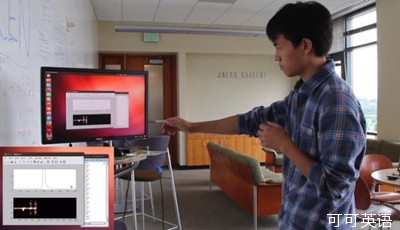Thanks to wi-fi we can watch movies, play games, and check e-mail, from the comfort of the couch.
多亏了wi-fi,我们可以在舒服的沙发上看电影,玩游戏,收发电子邮件。
And soon we may be able to repurpose our wi-fi signals so we can turn on the coffeemaker or turn off the TV with a simple flick of a finger, from anywhere in the house.
而很快我们就可以改变自己的wi-fi信号,或者只需要简单的轻敲手指就可以在房间的任何角落打开咖啡壶或关掉电视。
Researchers described their prospective system, called WiSee, at the International Conference on Mobile Computing and Networking.
在移动计算与网络国际会议上的研究人员称他们这个未来的系统为WiSee。
 The idea is similar in concept to the Xbox Kinect, which uses cameras to recognize a game player’s movements, and translates them into an action onscreen.
The idea is similar in concept to the Xbox Kinect, which uses cameras to recognize a game player’s movements, and translates them into an action onscreen.
这个想法和使用摄像头识别一名游戏玩家的动作,并将其转换为屏幕上动作的Xbox Kinect概念如出一辙,
But WiSee works without cameras.
但WiSee可没有摄像头。
Instead, it uses the ambient wireless signals put out by our smart phones, laptops, routers and tablets.
取而代之的是它使用由我们的智能手机,平板电脑,路由器及笔记本电脑所发出的无线信号环境。
When we move, we alter the patterns of these wi-fi signals.
当我们动的时候时,我们会改变这些wi-fi信号的模式。
The WiSee receiver detects these disturbances and interprets the motions that caused them, like waving or swinging your fists.
WiSee接收机会检测这些波动及分析这些运动,比如挥舞或摆动你的拳头。
Of 900 gestures tested, WiSee could identify 94 percent.
在900种的姿势测试中,WiSee可以识别其中的94%。
The user assigns a particular motion to a specific gadget—the motion doesn’t have to be the one that works in the real world.
用户可以分配一种特定的动作给一个特定电器,并不需要在现实世界的运动。
So if all goes well, you may actually be able to punch your lights out.
所以,如果一切顺利,你实际上也许能凭空挥拳来关闭电灯。
 The idea is similar in concept to the Xbox Kinect, which uses cameras to recognize a game player’s movements, and translates them into an action onscreen.
The idea is similar in concept to the Xbox Kinect, which uses cameras to recognize a game player’s movements, and translates them into an action onscreen.











